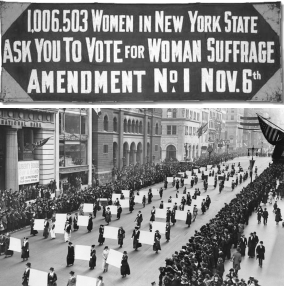Westchester Women and Their Fight to Win the Vote
(This post?was originally published on Aug. 26, 2015)
Happy Womens Equality Day! Today (Aug. 26) we celebrate Americas success in providing equal rights for women, while acknowledging that there is still more to be done when it comes to true equality for women.
Womens Equality Day was started by Rep. Bella Abzug in 1971 to recognize the passage of the 19th Amendment?on Aug. 18, 1920, which gave women voting rights in the U.S.
Here are some facts about the Westchester women who decided almost 100 years ago that they deserved the same rights as men, and did something about it.
- Westchester women already had the right to vote by the time the 19th Amendment was passed. New York women won the right to vote in state elections in 1917, after an earlier vote in 1915 was defeated. According to the New York Times, every single town in Westchester passed the bill.
- A Westchester woman devised the Winning Plan that gave women the right to vote in New York and resulted in the ratification of the 19th Amendment. According to the Library of Congress, New Rochelle resident Carrie Chapman Catt served at the President of the National American Woman Suffrage Association (NAWSA), which boasted 2 million members under her leadership. She also founded what later became the New York State of League of Women Voters.
- In her 1987 New York Times article, Tessa Melvin wrote that, Nowhere was the effort to gain the right to the state vote more intense than in Westchester Melvins research found that the suffrage movement spread from New Rochelle, to Briarcliff Manor and had 20,000 members at one point with 102 suffragette clubs.
- The first president of the New York League of Womens Voters was from Westchester. ?As president, Narcissa Cox Vanderlip of Scarborough (Briarcliff Manor) and the LWV fought for: unemployment insurance, health insurance, federal and state pensions for the elderly, an end to child labor, minimum-wage and maximum-hour legislation, federal aid to education, civil service reform, full citizenship for women, women’s full political participation, pure-milk-and-food legislation, and international peace, according to George Washington Universitys, Eleanor Roosevelt Papers Project. She was described as a champion of the underdog.
- Hundreds of Westchester women signed petitions sponsored by the New York State Women Suffrage Party in 1917, the majority of signatures came from Yonkers. The signatures were discovered at an Ossining Masonic Building on five boards that had handles to carry during protests and parades, according to the Westchester Historical Society Archives.?You can view the boards here and search the list of signatures here. The list is separated by town.

